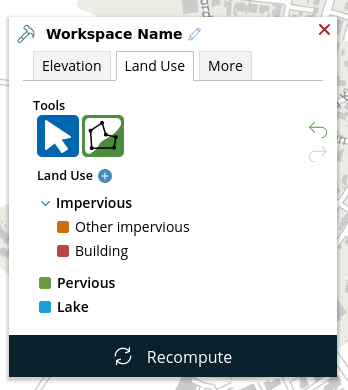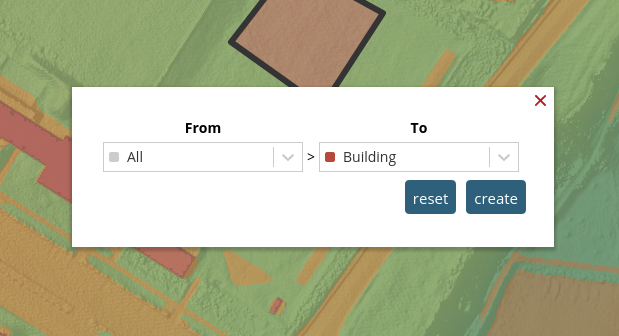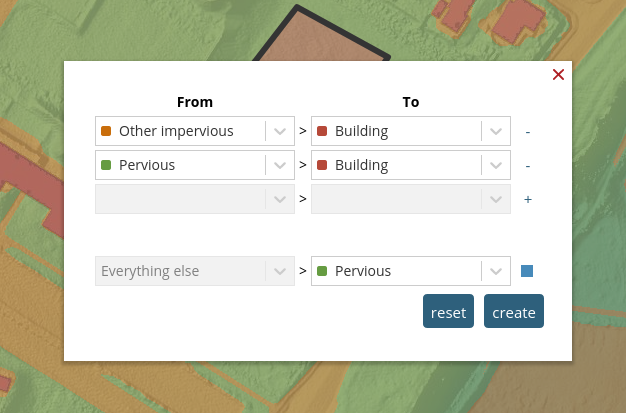-
Documentation
-
About
- Getting Started & Use Cases
- Support
-
What's new
- Specify basins and protrusions by drawing their outer boundary
- Simplified path features
- National Norwegian high-resolution land cover map
- Organise and communicate on a digital canvas
- New sidebar to help organize your analyses and queries
- Sliding contours
- Ny skyfallsanalys och en ännu bättre marktäckekarta
- New land cover map for Finland
- Depths in the depression map
- New Danish land cover map with more classes
- National Swedish High-Resolution Impervious Surface Mapping
- Watershed tool updated with even better descriptions of catchment characteristics
- National Flash Flood Map with Infiltration and Drainage for Denmark
- Add your own WMS layers to SCALGO Live
- Enriched building data in Denmark
- National hydrological corrections and Land Cover for Poland
- National hydrological corrections for Norway
- Updated Impervious Surface Mapping for Denmark
- National hydrological corrections and updated local data for Finland
- Fast and intuitive tools to work with infiltration and land use
- Improvements to vector imports and exports
- National Danish groundwater model
- New Sweden high-resolution model
- New powerful depression map and more analyses visualization options
- Introducing Modelspaces: Get your hydrodynamic models into SCALGO Live
- Use case videos
- Access a EA flood maps inside SCALGO Live
- Improved map export
- New powerful ways to edit the elevation model
- Better coloring of flooding layers and sea-level depth filtering
- National Danish High-Resolution Impervious Surface Mapping
- National access for local and regional organizations
- Simpler, more powerful downloads
- Customize Layer Transparency
- Hydrological corrections and new data in Sweden
- Improved export functionality
- Access a wide range of authorative data inside SCALGO Live
- Importing VASP data
- Measure gradients, undo edits, and Norway updates
- New terrain edit features, soil balance information and much more...
- Browse historical orthophotos in SCALGO Live
- Emergency planning with sea-level rise from national forecast data
- Detailed information about watershed composition
- Better styling of imported vector layers
- New Danish Elevation Model
- Work with gradients in the profile widget
- Flood risk screening from rivers and flow paths
- New workspace tool: Raise and lower terrain uniformly
- Importing LandXML TINs, LAS point clouds
- New model in Sweden
- Side slopes on workspace features
- Drag and drop enhancements
- Swedish contour maps
- Subsurface basins and sewage drains in workspaces
- New Interface
- Volume information for watersheds and flow paths
- New powerful tool for emergency response and coastal flood prevention
- Denmark: New flash flood map
- Sweden: Geodatasamverkan setting for Swedish users
- Import custom terrain models
- New Hydrological Corrections
- Elevation contours now available
- Download orthophotos as JPEG and PNG
- Subsurface structures in workspace
- Sea-levels in terrain profiles
- Updated orthophotos
- Models and analysis update
- User interface updates
- User interface updates
- GeoDanmark/FOT data, Matrikelkortet now available
- New flash flood map
- Download of risk polygons
- Updated orthophotos
- Nationwide hydrology on the new DHM/2015 model now available
- New flash flood map computation available with watershed download
- DHM/2015 variants and sea-levels now available nationwide
- DHM/2015 now available nationwide
- Hydrology on the new DHM/2015 model now available
- New DHM/2015 Model - now with buildings
- New DHM Model
- Watershed Tool
- Ad hoc layers
- Nationwide contour maps for all countries
- User Interface
- Canvas
- Analysis
- Workspaces
- Hydrodynamic Engine
- Streams and Flow
- Modelspaces
- Country Specific
-
About
Workspaces – Editing land cover
Workspaces allow you to define and edit land cover types within your area of interest. Land cover mapping is not only interesting in its own right, it can also be used to control the amount of runoff from each land cover type in the flash flood analysis. You can read more about this in the documentation for the Flash Flood Map.
You access the land cover editing tools through the following steps:
- Select the toolbox icon
for the workspace you want to edit.
- Select the Land Cover tab.
The land cover tab looks like this:

From this dialog you can:
- Define land cover for areas within the workspace by creating or importing polygonal features.
- Create new types of land cover , or edit the names and groupings of the existing types.
Editing the runoff parameters for the different land cover types is done in the Flash Flood Map infiltration dialog.
Creating land cover features

Enable the polygon tool to create a new land cover polygon by drawing on the map. Once you have created your polygon you can enter rules that govern how the land cover is affected by the polygon. See further down on this page for how to define these rules. If you have a vector file with features you can import those as well, read more about this further down on this page.
Modifying land cover features

You modify existing features using the select tool. It lets you select any of the land cover features in the workspace. Once selected, the position of any vertex of a feature can be changed interactively by dragging the vertex. New vertices can be created by clicking anywhere on the feature boundary, while vertices can be deleted by clicking on the vertex with the ctrl-key held down. You can also move an entire feature by clicking and dragging it in the interior of an area feature or by holding the shift-key while clicking.
When selecting a feature, the path info dialog appears in the bottom right corner and enables you to:
- Change the land cover rules.
- Set a comment for the land cover feature.
- Change the land cover features order relative to other potentially intersecting land cover features.
- Delete the feature.
Undo and Redo

You can undo your land cover modifications to the workspace one step at a time, using the green undo button. Once you have undone a modification, you can perform it again using the redo button below.
Only modifications that are less than one week old can be undone. The buttons are greyed out when no modification can be undone or redone.
Rules for modifying land cover
A land cover feature modifies the land cover in a given area according to a simple set of rules. The most simple rule is that everything under the polygon should become a particular land cover type. This rule looks like this:

But you can also make more complicated rules where different types of land cover are modified separately:

The catch-all "Everything else" category can be disabled by unchecking the checkbox to the right. If this checkbox is unchecked, the types that do not match any of the left-hand-side types in the rules above are kept unchanged.
Managing land cover types
The list of land cover types defined in the workspace is shown at the bottom of the land cover tab. You can create new land cover types and groups of types, and you can move types between groups by dragging and dropping them with your mouse. It is not possible to change the order of land cover types within a category.

The effect of the land cover types on the Flash Flood Map is controlled from the Flash Flood Map infiltration dialog.
Importing land cover data
Do you have land cover information in a vector file? You can drag it onto the land cover tab to import the features into the workspace. During the import process you can choose to either turn all the imported features into a particular land cover type, or you can select one of the fields in your file and control how each feature is converted to a land cover type based on the value of this particular field. If you want to create new types and assign those types automatically based on the value of the field, that is also an option. See the section on Importing terrain edits for more information on supported vector formats.